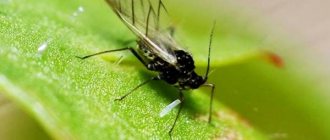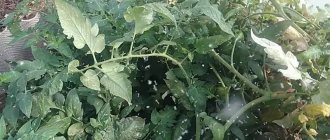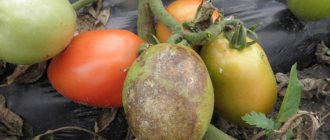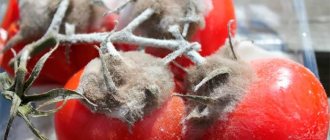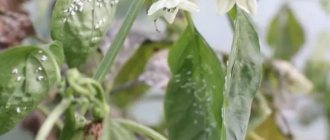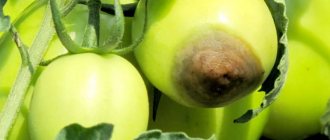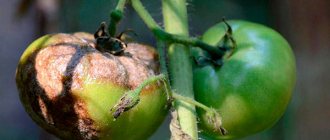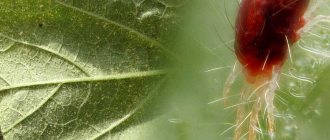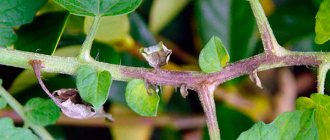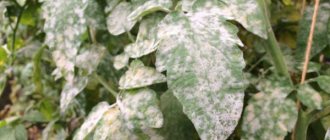Author: Tamara Altova. 09 September 2018
Category: Plant pests.
Cutworms are small whitish moths that resemble house moths and feed on garden crops. Moreover, it is not butterflies that damage plants, but their larvae - caterpillars. We will tell you how to deal with cutworms on tomatoes, which remedy for cutworms on tomatoes is considered the most effective, what folk remedies are available to combat cutworms and what chemicals will help get rid of this pest in tomato beds.
How to detect tomato cutworm in time
A careful inspection of the tomato bed will reveal signs of damage. The vegetable grower will not be able to see the butterfly itself. But the caterpillar feeds and traces of its “dinners” can be found. To do this you should inspect:
- leaves, especially the lower ones;
- shoots;
- buds;
- flowers.
Unfortunately, the vegetable grower becomes aware of the presence of cutworms on the plot only when he sees huge holes in the tomatoes. Sometimes you can see a caterpillar in them. Having made a hole, she decides not to leave, but to rest where she had eaten.
Other ways to fight
To repel cutworms, repellent plants can be planted between tomato beds, as well as along the perimeter of the plot. These include calendula, cilantro and basil. They have a distinct aroma that repels cutworms and other insect pests.
Some vegetable growers collect cutworm caterpillars by hand. But this method can only be used with a small number of tomato bushes. In a large garden, manual collection of pests becomes impossible.
Biological preparations Bitoxibacillin, Lepidocid, Actofit, Agravertin are considered effective means for exterminating adult cutworms and their caterpillars. Bitoxibacillin is a highly effective microbiological insecticide designed to combat all lepidopteran insects on the site. The solution is prepared in the proportion specified in the instructions. Treatment with Bitoxibacillin is carried out at intervals of 8 days.
Reasons for appearance
Sometimes a vegetable grower does not even suspect that there are cutworms on his plot. Pre-winter plowing and severe frosts regulate the pest population. Those that survive do not do much harm, except for a few eaten tomatoes.
The situation is different in the southern regions. The armyworm population is growing from year to year and it is becoming more and more difficult to fight. This is possible for the following reasons:
- Lack of autumn farming culture. If it is not customary to plow the soil in the fall or dig up the garden, the pupa becomes inaccessible to frost.
- Not thoroughly removing weeds and plant debris after harvesting the garden.
- A huge number of weeds in the garden or neighbors' plots. In this case, she has every chance of remaining unnoticed and continuing to reproduce.
Attention! If frost helps northerners, then southerners should clean their gardens more carefully.
Salt to protect against caterpillars on tomatoes: recipe for use
Salt can also be used to remove cutworms from tomatoes.
Instructions:
- To do this, you need to dissolve 400 g of salt in 5 liters of water.
- This strong saline solution must be sprayed on the leaves. Try to work on the reverse side as well.
- You can also treat leaves that are as close to the ground as possible. This will help eliminate caterpillar attacks on leaves.
The saline solution turns out to be quite liquid, so in order for the liquid to stick well to the leaves, you can add 50 g of grated laundry soap to the resulting solution. It is crushed, added to water and stirred until the soap flakes dissolve. Mix with saline solution.
Salt from a scoop
Signs of defeat
The cutworm butterfly can only be seen at night. But its presence in a tomato plot is not difficult to notice:
- If you look closely at the underside of tomato leaves, you can see eggs. If there are not many insects, then searching for oviposition may be difficult;
- the lower leaves on the tomato bushes, and then the upper ones, become scabbed. The caterpillar eats away the soft tissue of the leaf blade, but the vein remains. So she moves from the lower leaf to the upper one, leaving behind the skeletons of the leaves;
- You can catch the caterpillar eating and examine it late in the evening, when it has already climbed up the shoot to the leaf;
- if there are a lot of insects, then the tomato plantings look gloomy: the leaves and buds are worn out, the fruits are holed. Further, the caterpillar becomes more and more voracious and the tomatoes become covered with eaten holes;
- the gnawed leaf begins to turn black and dry out;
- large brown tomatoes are trying to heal, but they have little success. The process of decay begins.
Maliciousness
Potato cutworm larvae are harmful. These voracious creatures do quite a lot of damage to vegetable and berry crops. Crawling deep into the stem and fruit, they eat holes in them. In addition, this parasite is capable of nibbling the ovaries of berry crops, flowers and even rhizomes. As a result, the infected bush begins to wither, dry out and lose foliage.
The potato cutworm is especially dangerous in waterlogged areas. As you know, humidity promotes the development of pathogenic microorganisms that easily penetrate the body of the affected plant. The pest gnaws the stem at the soil level, enters the tuber through it and continues active feeding. Thus, the skin of the fruit remains intact, while its pulp is almost destroyed.
On a note! If an area is heavily infested with potato cutworms, you can lose up to 50% of the fruit!
This type of cutworm feeds not only on potatoes. This pest often affects:
Life cycle
Depending on the species and area of distribution, the life cycle differs slightly in time, but is basically as follows:
- a butterfly that lays eggs on a leaf plate at night;
- they mature and after some time the larva, the caterpillar, hatches;
- young caterpillars feed on the leaf and, as they grow, move away from each other in search of food;
- During the growth period, they molt and, having reached maturity, fall to the ground to pupate. By secreting sticky substances and sticking dust to itself, the cocoon becomes the same as that of other butterflies. It can lie on the ground or be slightly buried 2-4 cm in the ground. The growth of the pupa lasts from 3 to 30 days;
- After some time in the summer, a butterfly flies out of the pupa. If it is deep autumn, the pupa overwinters in the ground;
- The emerging butterfly still needs food for the maturation of reproductive products. For several days she feeds on pollen, then mates;
- Now she again lays eggs on the bottom of the leaf.
The life cycle of the cutworm in northern latitudes is interrupted by cold and frost. In the southern regions it is continuous.
Characteristic
As you can see in the photo, the potato cutworm (imago) is a butterfly with grayish-brown fore wings, the span of which can be from 28 to 40 mm. They show dark brown transverse lines, spots and a wide border running along the edge. The hind wings are yellow-pink or grayish-yellow, with a dark stripe in the apical third. There are a pair of long antennae on the head, they are wide at the base and taper towards the tips.
The potato cutworm larva is a small caterpillar whose body can range in color from light yellow to red-brown or gray-brown. A dark stripe runs along the back. The head is a darker shade, without spots or lines. The chest shield is brown, the supporting setae are red-brown, the spiracles are black. The body length of the larvae averages from 40 to 45 mm.
The potato cutworm pupa is yellow-brown in color and approximately 18-23 mm long.
The eggs are hemispherical. At first they are painted in a light yellowish color, later their color changes and takes on a pink tint. The egg is small in diameter - up to 0.8 mm, in height - no more than 0.4 mm.
The fertility of female potato cutworms is from 70 to 90 eggs. In August-September, butterflies lay eggs on foliage or on the lower part of the stem of wild food plants, placing eggs in parallel rows. There can be from 20 to 45 eggs in one row. Being in the stage of embryonic development, parasites survive the winter.
On a note! Younger caterpillars can also overwinter in the soil!
With the arrival of stable warmth - around the end of April or the first ten days of May - caterpillars emerge from the eggs, go to the above-ground part of thick-stemmed plants and begin active feeding. Having reached an older age, the larvae descend to the upper layers of the soil, where they pupate. Subsequently, adults emerge from the pupa.
Prevention measures
Farming practices will greatly help to get rid of armyworms on tomatoes in large quantities, although it is difficult to completely defeat the pest. By adhering to simple rules and following agrotechnical methods, you can protect the crop already in the next season. To do this you need:
- carry out autumn plowing of the garden and fallow;
- monitor the cleanliness of the vegetable plot and promptly control weeds;
- carry out regular irrigation of crops. It has been observed that noctuid moth pupation does not occur on irrigated soils;
- Apply insecticides promptly to combat armyworm caterpillars.
Additional Tips
Timely use of chemicals or home recipes to get rid of caterpillars can give good results.
Here are some more useful tips to help make your fight against armyworms more effective:
- when treating tomato bushes with chemicals, you must strictly follow the instructions indicated on the packaging;
- observe the timing of repeated treatments of tomatoes; on average, the interval between sprayings is from 7 to 14 days;
- chemicals against the pest are used only during the growth and flowering of tomatoes or the formation of ovaries;
- to destroy caterpillars hiding in the ground during the day, regularly loosen the soil between the rows of tomatoes;
- If a small number of pest eggs are found on plant leaves, they can be carefully collected by hand until the caterpillars appear.
Important! To combat the cutworm during the ripening and harvesting period of tomatoes, only folk remedies are used.
What does a tomato scoop look like photo
Looking at the photo of the scoop, you can understand that moths have an unusual and very diverse color. We must remember that they are all pests and eat everything.
The classification of cutworms is approximate and is constantly being improved. This is why one scoop is often confused with another, and this is not strange.
Why do caterpillars appear in a greenhouse?
Caterpillars enter the greenhouse in two main ways:
- An adult flew into a greenhouse and laid eggs. Caterpillars have already developed from them.
- The soil in the greenhouse is contaminated - pupae and larvae remain from last season. With the onset of warmth, they become active, quickly develop and reproduce.
Cutworms and whiteflies are attracted by the comfortable greenhouse microclimate - warmth, humidity. Therefore, I do not forget to ventilate the greenhouse to get rid of condensation and ensure normal air circulation.
Pests also love overly thickened plantings - they lay eggs there. Therefore, timely weeding, thinning, and formation of cultivated plants are so important. Do not forget to cut off stepsons, old lower branches, and unnecessary side shoots.
A folk remedy for a hangover from the “piggy bank” of our ancestors or 8 best options
No. 1. Brine
For Russians, brine has become synonymous with the word “hangover.” It is with this remedy that many people treat themselves after a stormy feast. Why does brine help cure a hangover? It contains substances such as magnesium, potassium and sodium. It is these valuable elements that were lost by your body when excreting excess alcohol.
For brine to help with a hangover, you need to give preference to pickled vegetables: cabbage, tomatoes, cucumbers.
It is worth taking this folk remedy in an amount of no more than one glass, because it contains a lot of salt, which retains water. There is also a lot of acid in the brine, which is in excess in the body during a hangover. Therefore, excessive use of this drug can worsen your health.
No. 2. Tomato
Tomato juice and tomatoes themselves help saturate the body with vitamin C, potassium, sodium, acids and magnesium. This product improves stomach function.
Choose any folk remedy for a hangover using tomato:
| 1. | Add a pinch of ground red pepper to a glass of fresh tomato juice. This drink will help speed up your metabolism, which will allow you to remove toxins from your body faster. |
| 2. | Mix a glass of tomato juice in a blender with an egg and a pinch of salt. |
| 3. | A good hangover cure is a drink in which the ratio of tomato and kefir is 1:1. |
No. 3. Tea
To restore strength, it is better to use re-infusion rather than fresh. Add honey and lemon to your cup of tea to taste. If you experience vomiting and nausea during a hangover, then add ginger root to your tea. It helps improve stomach function.
No. 4. Eggs
An effective folk remedy for a hangover is a raw egg. The thing is that the white of a chicken egg prevents toxins from entering the blood. This property prevents a hangover from lasting for a long time.
Take note of this popular recipe:
- Shake 2 raw eggs
- add a pinch of salt,
- drink on an empty stomach.
You will notice the effect of this product literally after an hour.
No. 5. Dairy products
Any fermented milk product helps normalize stomach function, help restore the balance of minerals, speed up metabolism, quench thirst, and remove toxins.
Preference should be given to kefir, yogurt without additives, milk, curdled milk, fermented baked milk. It all depends on your personal preferences.
The use of this folk remedy has a number of indications:
- Sour milk should be at room temperature.
- It is better to take it immediately after waking up.
- You are allowed to drink no more than 700 ml per day.
- For the effect to be immediate, you do not need to mix fermented milk products with other foods.
No. 6. Bay leaf
Few people know that there is such a folk remedy for a hangover as a decoction of bay leaves.
It doesn’t matter at all whether you take dry or fresh leaves. This well-known nutritional supplement helps calm the nervous system, as well as cleanse the internal organs of poisons. Bay leaf has a sedative, diuretic, antiviral and antibacterial effect on the body.
Bay leaf has a sedative, diuretic, antiviral and antibacterial effect on the body.
To prepare a folk remedy for a hangover based on bay leaves, take 4 grams of the plant and 100 ml of water. This combination must be simmered for 10 minutes over low heat. Once the broth has cooled, divide it into equal portions and drink throughout the day. The maximum allowable volume is 2 glasses.
No. 7. Vitamin C
Lemon is a product accessible to absolutely every person. During a hangover, it helps get rid of nausea, speed up the processing of alcohol and the removal of toxins, eliminate headaches, normalize urination, and relieve fatigue.
There are two options for using it as a folk remedy for a hangover:
- The first is to eat lemon without sugar.
- If this option is not suitable for you, then simply add this product to mineral water. This drink perfectly quenches thirst and helps you forget about nausea.
Preventive methods
Pest control is not that easy. It is better to avoid insects. To do this, preventive maintenance is done annually:
- after the end of the season, be sure to collect all the remains and burn them;
- In the fall, they dig deep into the greenhouse soil. Remove more than 15 cm of soil and replace it with fresh soil;
- disinfect the soil, water it with boiling water or potassium permanganate;
- dig up periodically so that there are no weeds;
- water the seedlings at the roots in the morning so that the moisture evaporates until the evening;
- if there are self-pollinating plants, install mosquito nets or hang a gauze or tulle curtain;
- treated with "Decis", "Citkor" with a break of 7 days.
Harm
The most harmful are the gnawing caterpillars - exclamation and winter.
The fall armyworm mainly destroys cabbage and carrots, and winter crops. The first generation caterpillars begin to actively destroy crops in mid-summer. Young shoots of sunflower, rapeseed, millet, and corn suffer the most. The second generation larvae eat planted winter grains.
Plants damaged by the pest die. Basically, the larvae begin their “work” from the edges of the field, then the damage spreads in spots that grow into large bald spots.
Cabbage and garden caterpillars are considered leaf-eating. White cabbage suffers the most from them. The larvae make passages in the head of cabbage and leave behind a trail of liquid waste products. A head of cabbage damaged by the cutworm quickly rots and gives off an infection that can infect other plants.
In broccoli, the pest damages not only the head, but also the leaves. The armyworm also affects other vegetable crops - tomatoes, carrots, beets, cabbage, rapeseed, potatoes, onions, turnips, bell peppers, peas, radishes, and beans. The larvae infect plants in open ground and can make their way into greenhouses. Individuals of the 1st and 2nd instars eat the leaves; adults, in addition to the leaves, also consume the pulp of the fruit. In root vegetables, the caterpillar can eat through an entire cavity, leaving the peel almost untouched.
Expert opinion
Mityuk Stefania Bogdanovna
One caterpillar can destroy up to 15 young plants per day.
Description
The front wings are brick-burgundy or dirty gray in color. The hind wings are much smaller than the front wings and are reddish, dark gray or blue in color.
Butterflies rarely fly during the day, mainly at dusk or at night. At the caterpillar stage, individuals live in the ground, feeding on roots, root crops or the above-ground parts of plants. Entire cavities in root vegetables are eaten away, leaving the skin intact.
